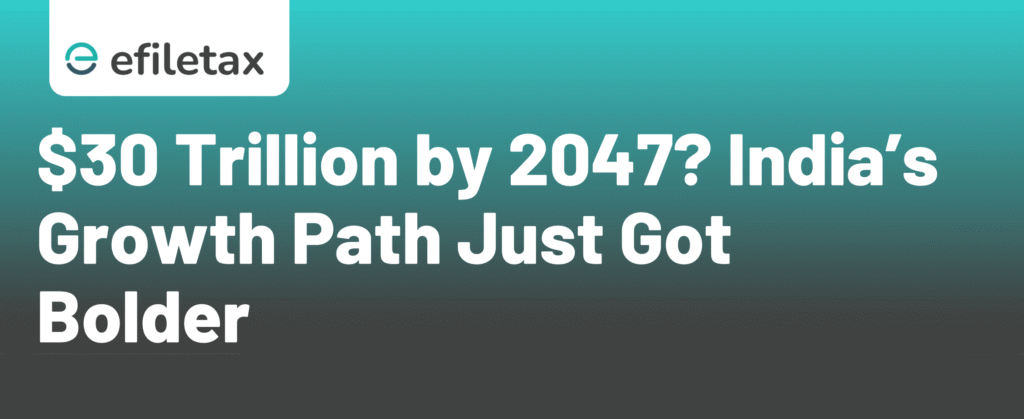
India’s Economy to Reach $30 Trillion by 2047 What It Means for Taxpayers
It’s a roadmap that carries deep implications for taxpayers, consultants, small businesses, and compliance professionals across the country.
Let’s break it down in simple terms.
Why the $30 Trillion Vision Matters
As per Amitabh Kant’s remarks at industry events and NITI Aayog discussions, India’s transformation by 2047 depends on:
- High-value manufacturing
- Export-led growth
- Technology and green energy adoption
- Massive formalisation of the economy
All of these directly affect how the tax system, regulatory environment, and financial discipline will evolve.
What Taxpayers Should Expect in a $30 Trillion Economy
| Area | Expected Change |
|---|---|
| Income Tax System | More digitised, possibly a unified or simplified code replacing IT Act, 1961 |
| Compliance Monitoring | Real-time tax audits, advanced analytics in scrutiny |
| Business Reporting | Integrated filings across GST, Income Tax, ROC |
| Taxpayer Services | Faster refunds, AI-based assessments, multilingual portals |
| Penalties & Notices | Strict enforcement to curb evasion as the formal economy expands |
| Policy Shifts | More incentives for green tech, R&D, manufacturing exports |
Legal and Policy Framework Driving the Change
- Finance Bill 2025 already proposes a new Income-tax Act with simplified clauses
- GST reforms (like e-invoicing and amnesty schemes) aim at better compliance
- MCA and RBI digitisation efforts are aligning with this larger economic vision
Relevant source links:
Expert Tip: Compliance Is the New Currency
🔍 From Efiletax’s compliance desk:
“As India grows richer, transparency becomes non-negotiable. Taxpayers and consultants must stay ahead by automating filings, tracking legal changes, and avoiding last-minute disclosures.”
What Small Businesses Should Prepare For
- PAN-based tracking across tax systems
- Mandatory GST for more sectors as thresholds may reduce
- Export-linked tax reliefs becoming performance-based
- Startup-friendly regimes (but with stricter audit norms)
Keyphrase in Subheading: India’s $30 Trillion Economy and Your Taxes
This economic target means more scope for wealth creation, but also tighter regulatory oversight.
Here’s how to stay prepared:
- Stay updated with Income Tax and GST rule changes
- Use platforms like Efiletax to automate routine compliance
- Respond to notices and letters in a time-bound manner
- Adopt digital invoicing and record-keeping
Frequently Asked Questions (FAQ)
Q1. Will income tax rates increase in a $30 trillion economy?
Not necessarily. Governments may lower rates but widen the tax base through digital enforcement.
Q2. Will small businesses face higher compliance burden?
Yes, but with better tools and more support, compliance can become seamless.
Q3. What are the biggest risks of non-compliance by 2047?
Heavy penalties, loss of government incentives, and automatic scrutiny via AI-based systems.
Summary
India aims to be a $30 trillion economy by 2047. This will reshape tax laws, tighten compliance, and expand formalisation. Taxpayers must prepare for a digitised, transparent future using smart tools and timely legal advice.
Final Note: Prepare with Efiletax
At Efiletax, we help individuals and businesses stay tax-compliant with zero last-minute panic. From ITR filing to GST tracking — we’re your partner for India’s next growth era.